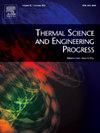Two-dimensional radiant conductivity model for heat-generating cylindrical porous media: Development and experimental validation
IF 5.1
3区 工程技术
Q2 ENERGY & FUELS
引用次数: 0
Abstract
Accurate mathematical models describing high-temperature porous bed heat transfer can provide insights into the optimisation of industrial processes and improve their thermodynamic efficiency. Several heat transfer models have been proposed for various applications to achieve this objective. However, the thermal radiation characterisation of porous beds is difficult partly due to the physical complexity and the shortage of experimental validation of reported numerical models. Estimation of porous bed temperature profile through the radiant conductivity method is a subject of extensive study. However, the reported methods are bereft of multidimensional and generalized applications. Such specificity in their application renders these methods highly restricted. This paper presents a novel two-dimensional radiant conductivity model for a heat-generating porous bed of cylindrical rods. The radiant conductivity is assigned as a function of the radiation exchange factor , and the average cylinder surface temperature . is estimated to be a function of the optical properties of the porous media. The presented model is verified and validated against a multi-dimensional experimental investigation of a heat-generating cylindrical bed with a deviation of less than 7 %. The proposed model is well adapted for estimating the thermal radiation field for various cylindrical bed configurations and can be easily implemented into the energy equation of the porous media. The radiant conductivity of the porous bed is revealed to be influenced by the arrangement of cylindrical rods and the number of interacting cylinders. The radiative field is estimated by the presented model with similar accuracy to the classical methods (for dilute systems; ) with a significant reduction in the computational cost.
热柱状多孔介质的二维辐射传导性模型:开发与实验验证
描述高温多孔床传热的精确数学模型可以为工业过程的优化提供见解,并提高其热力学效率。为了实现这一目标,已经为各种应用提出了几种传热模型。然而,多孔床的热辐射表征是困难的,部分原因是物理复杂性和缺乏实验验证的数值模型。利用辐射电导率法估算多孔床层温度分布是一个广泛研究的课题。然而,所报道的方法缺乏多维和广义的应用。这种应用上的特殊性使这些方法受到高度限制。本文提出了一种新的二维辐射导电性模型。辐射电导率被指定为辐射交换因子(F)和平均圆柱体表面温度(T¯)的函数。估计F是多孔介质光学性质的函数。通过对热柱床的多维实验验证了该模型的正确性,误差小于7%。该模型可以很好地适用于各种圆柱床结构的热辐射场的估计,并且可以很容易地应用到多孔介质的能量方程中。多孔床的辐射传导性受柱状棒的排列和相互作用柱体的数量的影响。用所提出的模型估计辐射场,其精度与经典方法相似(对于稀体系;孔隙度→1),计算成本显著降低。
本文章由计算机程序翻译,如有差异,请以英文原文为准。
求助全文
约1分钟内获得全文
求助全文
来源期刊

Thermal Science and Engineering Progress
Chemical Engineering-Fluid Flow and Transfer Processes
CiteScore
7.20
自引率
10.40%
发文量
327
审稿时长
41 days
期刊介绍:
Thermal Science and Engineering Progress (TSEP) publishes original, high-quality research articles that span activities ranging from fundamental scientific research and discussion of the more controversial thermodynamic theories, to developments in thermal engineering that are in many instances examples of the way scientists and engineers are addressing the challenges facing a growing population – smart cities and global warming – maximising thermodynamic efficiencies and minimising all heat losses. It is intended that these will be of current relevance and interest to industry, academia and other practitioners. It is evident that many specialised journals in thermal and, to some extent, in fluid disciplines tend to focus on topics that can be classified as fundamental in nature, or are ‘applied’ and near-market. Thermal Science and Engineering Progress will bridge the gap between these two areas, allowing authors to make an easy choice, should they or a journal editor feel that their papers are ‘out of scope’ when considering other journals. The range of topics covered by Thermal Science and Engineering Progress addresses the rapid rate of development being made in thermal transfer processes as they affect traditional fields, and important growth in the topical research areas of aerospace, thermal biological and medical systems, electronics and nano-technologies, renewable energy systems, food production (including agriculture), and the need to minimise man-made thermal impacts on climate change. Review articles on appropriate topics for TSEP are encouraged, although until TSEP is fully established, these will be limited in number. Before submitting such articles, please contact one of the Editors, or a member of the Editorial Advisory Board with an outline of your proposal and your expertise in the area of your review.
 求助内容:
求助内容: 应助结果提醒方式:
应助结果提醒方式:


